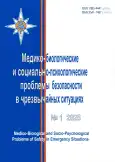Benefits of using imaging techniques for triage in inpatient emergency department
- Autores: Teplov V.M.1, Arkhangelskiy N.D.1, Tsebrovskaya E.A.1, Bagnenko S.F.1
-
Afiliações:
- Academician I.P. Pavlov First St. Petersburg State Medical University
- Edição: Nº 1 (2025)
- Páginas: 54-60
- Seção: Медицинские проблемы
- URL: https://ogarev-online.ru/1995-4441/article/view/289475
- DOI: https://doi.org/10.25016/2541-7487-2025-0-1-54-60
- ID: 289475
Citar
Texto integral
Resumo
Relevance. Imaging techniques allow to optimize inpatient medical triage in emergency medical care and enhance treatment outcomes. Today, such techniques as automated ECG interpretation (AIECG) and focused ultrasound (FUS) are highly relevant. However, the optimization efficiency in Russia is yet pending a thorough study.
Objective. The objective is to assess the efficiency of a three-level medical triage system, evaluating the contribution AIECG and FUS examination.
Methods. The study is a retrospective analysis of 1,000 patient cases of emergency medical care, provided by the inpatient emergency department at the Academician I.P. Pavlov First St. Petersburg State Medical University. Medical triage was based on the procedure developed at the Saint-Petersburg I.I. Dzhanelidze Research Institute of Emergency Medicine. All cases were split into categories based on the patient’s outcome (discharge or readmission), days of stay in the department, medical triage score. The collected data underwent statistical analysis.
Results and discussion. The median duration of stay per patient in the inpatient emergency department was 229 ± 12 minutes for green, 398.5 ± 19 minutes for yellow flow, and 233 ± 16 minutes for red, with an asymptotic significance p < 0.05. AUC-ROC analysis demonstrated statistically significant improvement in the triage sorting performance once AIECG and FUS were integrated. The area under the curve (AUC) increased to 0.752 compared to 0.581 in triage without imaging (p < 0.005).
Conclusion. The study shows that automated ECG interpretation and focused ultrasound allow to optimize medical triage, eventually rendering the three-tier medical triage procedure more efficient.
Sobre autores
Vadim Teplov
Academician I.P. Pavlov First St. Petersburg State Medical University
Autor responsável pela correspondência
Email: vadteplov@mail.ru
Dr. Med. Sci., head of the Department of Emergency Medical Care
Rússia, 6–8, Lev Tolstoy Str., St. Petersburg, 197022Nikita Arkhangelskiy
Academician I.P. Pavlov First St. Petersburg State Medical University
Email: arhanikmd@yandex.ru
emergency medical care physician, assistant of the department of emergency medical care and trauma surgery
Rússia, 6–8, Lev Tolstoy Str., St. Petersburg, 197022Ekaterina Tsebrovskaya
Academician I.P. Pavlov First St. Petersburg State Medical University
Email: tserina@bk.ru
PhD. Med. Sci., junior researcher at the laboratory of the Scientific Research Center, assistant in the department; ambulance care and surgery of injuries
Rússia, 6–8, Lev Tolstoy Str., St. Petersburg, 197022Sergey Bagnenko
Academician I.P. Pavlov First St. Petersburg State Medical University
Email: bagnenko_spb@mail.ru
Dr. Med. Sci. Prof., Member of the Russian Academy of Sciences, rector
Rússia, 6–8, Lev Tolstoy Str., St. Petersburg, 197022Bibliografia
- Alimov R.R. Nauchnoe obosnovanie sovershenstvovaniya okazaniya skoroi meditsinskoi pomoshchi v usloviyakh mnogoprofil’nogo statsionara [Scientific justification of improvement of rendering emergency medical service in the conditions of the versatile hospital : Abstract dissertation Dr. Med. Sci.]. St. Petersburg, 2018. 50 p. (In Russ).
- Bagnenko S.F., Minnullin I.P., Miroshnichenko A.G [et al.] Napravleniya sovershenstvovaniya organizatsii skoroi, v tom chisle skoroi spetsializirovannoi, meditsinskoi pomoshchi, spetsializirovannoi meditsinskoi pomoshchi v ekstrennoi i neotlozhnoi formakh i meditsinskoi evakuatsii v sub»ekte Rossiiskoi Federatsii [Directions for improving the organization of emergency medical services, specialized medical care and medical evacuation in federal subject of Russia]. Vestnik Roszdravnadzora. 2019; (3):70–74. doi: 10.35576/article_5d135f4a728e49.79827942. (In Russ).
- Bagnenko S.F., Polushin Yu.S., Miroshnichenko A.G. [et al.] Organizatsiya raboty statsionarnogo otdeleniya skoroi meditsinskoi pomoshchi [Organization of work of the inpatient emergency department]. St. Petersburg, 2015. 80 p.
- Rakhimova R.A., Dadamyants N.G., Nodirkhonova A.A. RUSH-protokol v praktike vracha ekstrennoi meditsinskoi pomoshchi [RUSH-protocol in the practice of an emergency physician]. Vestnik ekstrennoi meditsiny [The Bulletin of Emergency Medicine]. 2024; 17(1):83–92. doi: 10.54185/tbem/vol17_iss1/a12. (In Russ).
- Teplov V.M. Kontseptsiya trekhurovnevoi sistemy okazaniya skoroi meditsinskoi pomoshchi v sub”ekte Rossiiskoi Federatsii v rezhime povsednevnoi deyatel’nosti i pri chrezvychainykh situatsiyakh biologo-sotsial’nogo kharaktera [The concept of a three-level system of emergency medical care in the subject of the Russian Federation in the mode of daily activity and in emergency situations of a biological and social nature: Abstract dissertation Dr. Med. Sci.]. St. Petersburg, 2022. 50 p. (In Russ).
- Abagaro A.M., Barki H., Ayana G. [et al.]. Automated ECG Signals Analysis for Cardiac Abnormality Detection and Classification. J. Electr. Eng. Technol. 2024; 19:3355–3371. doi: 10.1007/s42835-024-01902-y.
- Chung C.T., Lee S., King E. [et al.]. Clinical significance, challenges and limitations in using artificial intelligence for electrocardiography-based diagnosis. Int. J. Arrhythm. 2022; 23:24. doi: 10.1186/s42444-022-00075-x.
- Osterwalder J., Polyzogopoulou E., Hoffmann B. Point-of-Care Ultrasound – History, Current and Evolving Clinical Concepts in Emergency Medicine. Int. J. Medicina. 2023; 59(12):2179. doi: 10.3390/medicina59122179.
Arquivos suplementares









